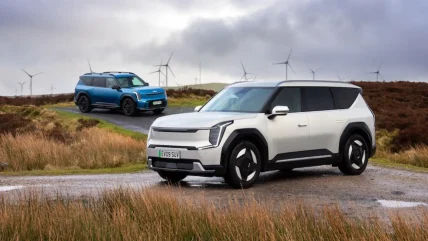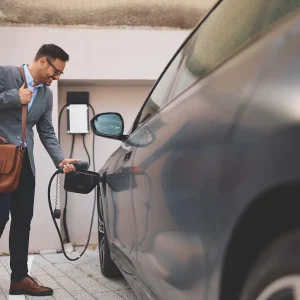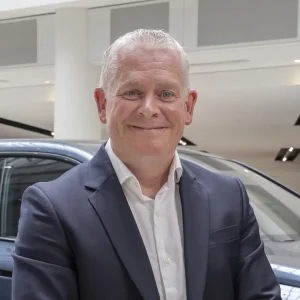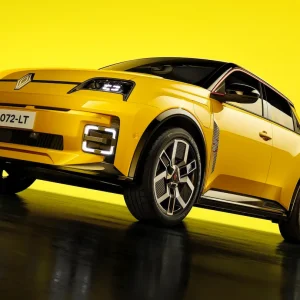
We first ask Paul Philpott what the corporate/fleet focus for Kia is this year? He says: “In corporate, we’re building up our credentials in the fleet marketplace, and this year’s focus is two-fold. One, is building our reputation further as a supplier of outstanding electric vehicles – which by 2030 needs to be 80% of our sales.
“So, we’re further putting building blocks in place around EVs, which now are the Niro EV, EV6, and EV9. With the EV3 SUV to come at the end of this year – which is a smaller SUV.
“The rate of progress we’re making with EVs is phenomenal, and I think clearly with the Benefit in Kind (BIK) advantage that EVs have for company car drivers, when there are no current incentives for retail buyers, fleet becomes really important to us for EVs.
“Alongside that, this year to meet our ZEV mandate requirements, we’re looking at a 20% mix of EVs, which means 80% are either ICE, Hybrid, or plug-in hybrid, and that continues, or maintains our momentum in fleet that we have.”
Philpott tells us that with Kia in key fleet sectors, there is more focus on the Sportage and Niro PHEV and hybrid versions. He says: “If you take Sportage and Niro together, they account for over 50% of our fleet sales. From a model line level, Sportage and Niro are our two best-selling products.
“If you take the core heartland of mid-size SUVs, and you add on EVs, then together they’re about two-thirds of everything we’ll sell.”
We go on to ask if he has noticed more interest in hybrid and plug-in hybrid models since the rolling back of the ICE engine ban to 2035? He says: “I think interest was always there. For many fleet customers, they’re not yet in a position where they can make the leap from an ICE vehicle to an EV, and therefore to have a hybrid or plug-in hybrid are useful stepping stones towards EVs.
“I think now the messaging is quite clear, at some stage in the future we will all be driving an EV. For those people that can have a home charger, and perhaps have access to charging at their place of work, then it’s starting to make real sense. But 80% of our buyers will be choosing ICE, hybrid, or plug-in hybrid models. I think to be a manufacturer that offers all four choices, including full EV, is a real benefit – because there aren’t many of us!”
The EV9 is the most expensive car you’ve produced, but is it more of a fleet car than Philpott thought? He says: “A journalist earlier asked me if there was retail demand for EVs now there are no incentives, and is it all about fleet for EVs? It is not, last year EV6 sales were 55% fleet and 45% retail, Niro was about 70:30, and early demand we’re seeing for EV9 is about 60:40. I think within fleet, there’s a lot of leasing to small businesses, entrepreneurs, and owner drivers who want to lease this model for three-years, and with its residual value being particularly strong, the monthly payments are very attractive.
“A lot of electric vehicle demand right now is conquest for us, but particularly with a big, seven-seat SUV. We’re seeing a lot more people come out of Audis, BMWs, Mercedes, and Range Rovers, than we’re seeing people come out of Sorento! It has opened us up to a whole new category of fleet customer, but I think there’s not a lot to touch it right now with seven seats of that size, it really positions us as a leader in electric vehicles.
“Our top seller is seven-seat, range-topping GT-Line S, because whilst I think the attraction is the £65,000 price point, when you break it done to a monthly payment, the extra goodies you get, for the incremental monthly payment is an easy win.”
EV sales are helped for fleet by the 2% BIK figure, but as the president and CEO of a company producing some very impressive EV models, we ask if it worries him about their second life? He says: “I think the current fleet support is good, and that is driving some real consideration amongst company car drivers – because it is a very attractive BIK rate.
“We would stand behind the SMMT’s request for retail support with a lower level of VAT. It doesn’t have to be no VAT, just a lower level of VAT, EVs are still priced above an equivalent ICE car, so they’re attracting more VAT revenue anyway. So, if they were to cut the VAT rate, then I think it would be really attractive for retail buyers.
“Going back to the scrappage scheme in 2009, it was only £1,000 per unit, of government support, matched by the manufacturer and dealer, it was £2,000 in total, and demand went through the roof.
“I don’t think there needs to be price parity between ICE and EVs, the running costs of an electric vehicle are substantially lower than the running costs of a petrol or diesel. I think therefore, when you work that through in a total cost of ownership, EVs make absolute sense. I think there are a group of customers that need to see that Government are prepared to support the take up of EVs at a faster pace.”
Next, we move on to daily rental, and we ask Philpott if Kia is doing much post-chip crisis? He says: “Through the decade between 2010 and Covid, we always set a limit on rental of 10% of our total volume. This year it will be around the 4% mark, so we have cut back really since Covid, and since we’ve enjoyed longer order banks, there has been less requirement to supply the rental market,
“We still have key rental partners, that we continue to have supply arrangements with. They are very valued relationships, but we don’t need to be doing 10% of our volume to rental companies.”





